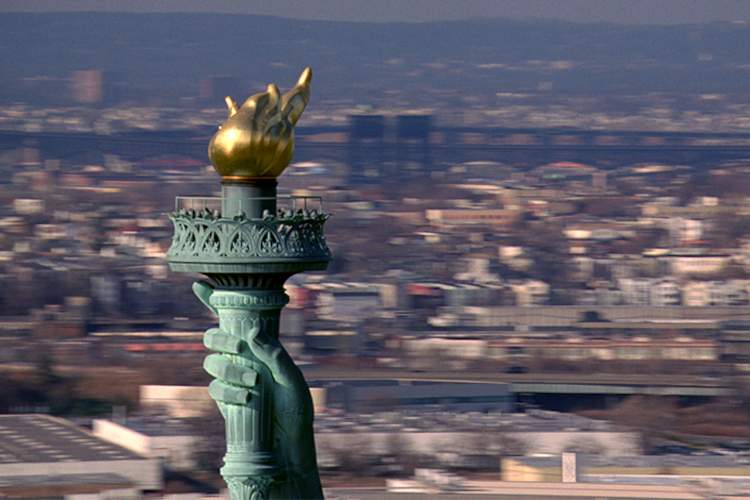From March 31 to July 31, 2022, Pirelli HangarBicocca presents the exhibition Sunshine State dedicated to Steve McQueen (London, 1969), Turner Prize and Oscar-winning artist and film-maker. Curated by Vicente Todolí, the exhibition is organized in collaboration with London’s Tate Modern, where a first version was presented in 2020 curated by Clara Kim, The Daskalopoulous Senior Curator, International Art and Fiontan Moran, Assistant Curator, International Art.
The exhibition project takes place in the space of the Naves and on one of the exterior walls and brings together some of the most significant works of McQueen’s career, as well as a new video installation titled Sunshine State: the work, which he had had in mind for more than two decades, was commissioned by theInternational Film Festival Rotterdam (IFFR) 2022 and premiered at Pirelli HangarBicocca.
Steve McQueen has influenced the way the film medium is used and exhibited, turning his radical gaze on the human condition, its dramas and fragility, and poignantly and provocatively capturing current issues, such as the construction of identity�?, the sense of belonging, and the right to freedom. In a career spanning more than twenty-five years, Steve McQueen has created some of the most significant works in the visual arts, using the film medium as a sculptural form moving through space and time. In 1999 he won the Turner Prize. He has also directed four feature films for cinema: Widows - Criminal Inheritance (Widows) (2018), 12 Years a Slave (12 Years a Slave) (2013), for which he won the Oscar for Best Picture, Shame (2010), Hunger (2008), with which he won the Caméra d’Or at the Cannes Film Festival. In 2020 he made his first five-episode mini-series Small Axe, and most recently documentaries for the BBC Uprising (2021), Black Power: A British Story of Resistance (2021) and Subnormal: A British Scandal (2021).
The six filmic works on display in the exhibition represent free narrative models and unexpected viewpoints on the broadest and most cross-cutting nuances of historical and contemporary social contexts. Within the exhibition spaces, it brings to life a visual and aural experience with which it intends to immerse the visitor in an unprecedented spatiotemporal dimension. Through a non-chronological path, the exhibition aims to trace McQueen’s career in the visual arts, highlighting the evolution of his practice over the past two decades.
The title of the exhibition refers to the artist’s unpublished work of the same name, Sunshine State (2022). It is a video that is a reflection on the beginnings of Hollywood cinema and how the silver screen has profoundly influenced the perception and construction of identity. The exhibition tour opens with Static (2009). Projected on a large screen, suspended in the center of the Square, aerial shots of the Statue of Liberty follow one another in rapid sequences. The disorienting close-up images of the monument question its symbolic function and capture the sense of instability and precariousness of the Western world’s idea of individual freedom. The film serves as a counterpoint to the work presented in the Cube and closing the exhibition, Western Deep (2002). The work takes the visitor into the depths of the Tau Tona gold mine in South Africa, known during apartheid as Western Deep, and offers a bitter insight into the harsh working conditions of the miners. Made on Super8 film, the grainy footage shows a claustrophobic, dark setting that contrasts with the more open, allegorical vision of the early work. Western Deep was created in conjunction with another of the artist’s films, Caribs’ Leap (2002). The work is divided into two parts: one is broadcast on an LED screen on the exterior walls of the Naves, the other is projected inside the exhibition space. The title refers to the dramatic 1651 moment of the French conquest of Grenada, the Caribbean island from which McQueen’s parents came. Rather than submit to colonial rule, some preferred to throw themselves off a cliff, choosing death over captivity and slavery. The film addresses the racialization and dehumanization of the black and indigenous body, colonized and enslaved. In Charlotte (2004) and Cold Breath (1999) Steve McQueen explores the body in its most intimate and material dimensions. The first of the two films, shot on film, features a close-up of actress Charlotte Rampling’s eye. The artist’s finger enters the shot, momentarily touching the woman’s eyelid and pupil. McQueen invites the viewer to become a witness to the scene, depicting the more voyeuristic aspects of the act of watching the transformation of a body from subject to physical, manipulable object. Similarly, Cold Breath shows the film-maker caressing, pulling and squeezing his own nipple. The obsessive movement of the fingers reveals the blurred boundaries between desire and violence, between pleasure and pain.
For more info: https://pirellihangarbicocca.org/
Image: Steve McQueen, Static (2009) ©Steve McQueen. Courtesy of the artist, Thomas Dane Gallery, and Marian Goodman Gallery.
 |
| At Pirelli HangarBicocca an exhibition dedicated to Steve McQueen, artist and film-maker |
Warning: the translation into English of the original Italian article was created using automatic tools. We undertake to review all articles, but we do not guarantee the total absence of inaccuracies in the translation due to the program. You can find the original by clicking on the ITA button. If you find any mistake,please contact us.